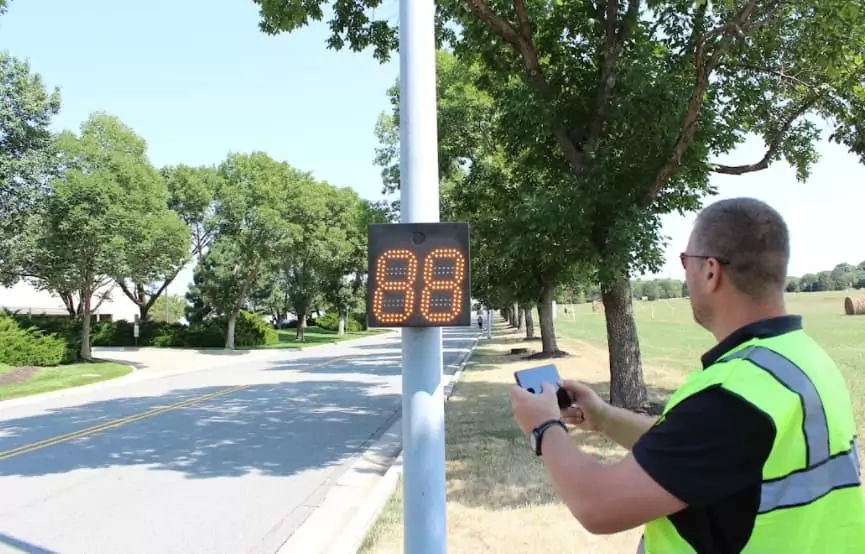Whether you’re in law enforcement or just a regular driver, we’re all familiar with RADAR speed displays. While static signs are still more commonplace, digital and dynamic speed signs are becoming an increasingly regular sighting on our nation’s roads. But how effective are these signs? Are they just gimmicks, or is there a real link between digital speed displays and safer roads?
HISTORY AND USE
Radar speed signs were first developed by 3M in 2001 in an attempt to slow down traffic in dangerous areas and accident hotspots. The signs use the same radar speed technology that police officers use to monitor vehicle speeds, then display vehicle speeds with large bright LED numbers as the vehicles approach. The idea is that many drivers don’t know that they’re speeding, or by how much. By informing drivers of their actual speed, it is hoped that speeding drivers will slow down.

The behavior that these radar speed signs are seeking to break is often referred to as ‘driving on autopilot’ or ‘highway hypnosis’. On average, drivers make eight journeys on familiar routes each week. These routes include work commutes (43% of weekly journeys), going shopping (16%), and highway driving (15%).
Drivers on their regular routes frequently break the speed limit (25% of the time), brake too late, and don’t stop at pedestrian crossings. This is because familiar routes can lead drivers to slip into this previously-mentioned ‘autopilot’ mode; 46% of these drivers say they don’t have full recollection of how they got to their destination. Radar speed signs seek to shake drivers out of this state of mind and make them more aware of their behavior and their surroundings.
The use of speed signs is heavily regulated in the USA, following standards set by the Federal Highway Administration (FHWA) of the United States Department of Transportation (USDOT). The MUTCD (Manual on Uniform Traffic Control Devices) is a standards document that has specified standards regarding sign size and letter height for Speed Limit Signs. Section 2B.13 of this document is the only section of the current revision of the MUTCD to mention the use of a radar speed sign and refers to them as “changeable message signs”, a term normally associated with work zone safety and the like. For this reason, it’s important that any purchaser of radar speed signs gets them from a provider that can assure they’re MUTCD compliant.
SCIENTIFIC STUDIES
There have been a number of studies around the world to gauge the efficacy of radar speed signs. A recent study from Finland looked at both the short- and long-term effects of these signs. The design was a before and after study with control sites in two street environments – busy and quiet streets connecting local streets to arterial roads. The speed displays were fixed to light poles 45–65 yards before a pedestrian crossing on a straight road section. On average, the study showed that most drivers dropped their speed by a couple of mph, but there was a more dramatic effect on speeding drivers. Cars going more than 5mph over the limit dropped their speed by an average of 10% of their previous speed.

Another study, set up in a school zone, showed even more dramatic results. Drivers dropped their speed by an average of 5-6mph, or 17.5% of their original speed. This would suggest that radar speed displays are even more effective in zones where drivers know they should be driving carefully. What’s more, both studies showed that the overall decrease in speed persisted throughout the entire length of the study, showing that there are both short and long-term benefits to posting the signs. In short, it’s scientifically proven that the signs have the intended effect of slowing drivers, especially speeders.
REDUCING FATALITIES
People who work outside of the area of law enforcement or traffic control often underestimate the effect that speed has on fatalities, particularly pedestrian fatalities. As an easy example, 9 out of 10 pedestrians will survive being hit by a car that is going at 20mph. However, this number drops to 5 out of 10 when the car is doing 30mph. If the car is going at 40mph, then only 1 in 10 pedestrians would be lucky enough to survive the collision.
While the actual reduction in miles per hour may not seem that high, this small difference has a genuine impact when it comes to saving lives. In the first study mentioned above, the speed reduction would result in an average of 20% fewer pedestrian fatalities. This clearly makes the installation of these signs a worthwhile investment for any community.

